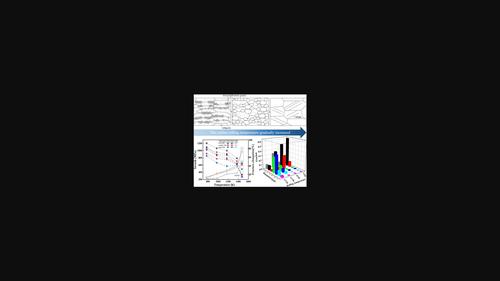当前位置:
X-MOL 学术
›
Steel Res. Int.
›
论文详情
Our official English website, www.x-mol.net, welcomes your feedback! (Note: you will need to create a separate account there.)
Effect of Caliber Rolling Temperatures on Microstructure Evolution and Mechanical Properties of High-Mn Steels
Steel Research International ( IF 2.2 ) Pub Date : 2022-03-30 , DOI: 10.1002/srin.202100810 WenXing Yu 1 , H.F. Chen 1 , ZhiLin Sun 1 , Wei Fang 1 , JianHang Feng 1 , Xin Zhang 1 , BaoXi Liu 1 , JiNing He 1 , FuXing Yin 1, 2, 3
Steel Research International ( IF 2.2 ) Pub Date : 2022-03-30 , DOI: 10.1002/srin.202100810 WenXing Yu 1 , H.F. Chen 1 , ZhiLin Sun 1 , Wei Fang 1 , JianHang Feng 1 , Xin Zhang 1 , BaoXi Liu 1 , JiNing He 1 , FuXing Yin 1, 2, 3
Affiliation

|
Three kinds of high-Mn steels are successfully fabricated by caliber rolling at different rolling temperatures, ranging from 773 to 1373 K. The effects of rolling temperature on the microstructure and mechanical properties of steels with different stacking fault energies (SFEs) are studied. With the increase in rolling temperature, the fibrous grains of the high-Mn steels transform into equiaxed grains, and the microstructure evolution mechanism changes from discontinuous dynamic recrystallization to continuous dynamic recrystallization. The yield strength and microhardness of the experimental samples increase significantly with decreasing caliber rolling (CR) temperature, while the samples sacrifice various degrees of plasticity. Fe–30Mn–4Si–2Al steel with low SFE value fabricated by warm CR has the best microhardness (512 HV) and yield strength (1078.82 MPa), as well as a notable fracture elongation (11.10%) among three experimental steels. This is mainly attributed to the stability of dislocations and the dislocations and twin/ε-martensite competitive mechanisms.
中文翻译:

口径轧制温度对高锰钢组织演变和力学性能的影响
通过在 773 到 1373 K 的不同轧制温度下成功轧制三种高锰钢。研究了轧制温度对不同层错能 (SFE) 钢的显微组织和力学性能的影响。随着轧制温度的升高,高锰钢的纤维状晶粒转变为等轴晶,显微组织演化机制由不连续动态再结晶转变为连续动态再结晶。实验样品的屈服强度和显微硬度随着口径轧制(CR)温度的降低而显着增加,而样品牺牲了不同程度的塑性。在三种实验钢中,由温铬制造的低 SFE 值 Fe-30Mn-4Si-2Al 钢具有最好的显微硬度(512 HV)和屈服强度(1078.82 MPa),以及显着的断裂伸长率(11.10%)。这主要归因于位错的稳定性以及位错和孪晶/ε-马氏体竞争机制。
更新日期:2022-03-30
中文翻译:

口径轧制温度对高锰钢组织演变和力学性能的影响
通过在 773 到 1373 K 的不同轧制温度下成功轧制三种高锰钢。研究了轧制温度对不同层错能 (SFE) 钢的显微组织和力学性能的影响。随着轧制温度的升高,高锰钢的纤维状晶粒转变为等轴晶,显微组织演化机制由不连续动态再结晶转变为连续动态再结晶。实验样品的屈服强度和显微硬度随着口径轧制(CR)温度的降低而显着增加,而样品牺牲了不同程度的塑性。在三种实验钢中,由温铬制造的低 SFE 值 Fe-30Mn-4Si-2Al 钢具有最好的显微硬度(512 HV)和屈服强度(1078.82 MPa),以及显着的断裂伸长率(11.10%)。这主要归因于位错的稳定性以及位错和孪晶/ε-马氏体竞争机制。


























 京公网安备 11010802027423号
京公网安备 11010802027423号